Saudi Arabia Auto Finance Market Outlook to 2029
By Market Structure, By Lenders, By Vehicle Type, By Financing Type, By Consumer Age Group, and By Region.
- Product Code: TDR0137
- Region: Middle East
- Published on: April 2025
- Total Pages: 110
Introducing the World's FirstPay-Per-Section Market Reports
Why pay for the full report when you need just a part?
Start Building Your Report
Scroll down to see available sections
Report Summary
The report titled "Saudi Arabia Auto Finance Market Outlook to 2029 - By Market Structure, By Lenders, By Vehicle Type, By Financing Type, By Consumer Age Group, and By Region." provides a comprehensive analysis of the auto finance market in Saudi Arabia. The report covers an overview and genesis of the industry, overall market size in terms of revenue, market segmentation; trends and developments, regulatory landscape, customer level profiling, issues and challenges, and comparative landscape including competition scenario, cross comparison, opportunities and bottlenecks, and company profiling of major players in the Auto Finance Market. The report concludes with future market projections based on financing revenue, by market, product types, region, cause and effect relationship, and success case studies highlighting the major opportunities and cautions.
Saudi Arabia Auto Finance Market Overview and Size
The Saudi Arabia auto finance market reached a valuation of SAR 40 billion in 2023, driven by increasing demand for vehicle ownership, government initiatives to boost financial inclusion, and the expansion of digital lending platforms. The market is characterized by major players such as Al Rajhi Bank, Saudi National Bank, Riyad Bank, Alinma Bank, and Banque Saudi Fransi. These institutions are recognized for their extensive financial offerings, innovative loan structures, and customer-focused financing solutions.
In 2023, Saudi National Bank launched an AI-powered loan approval system to enhance the customer experience and streamline financing applications for auto loans. This initiative aims to tap into the growing digital financial ecosystem in Saudi Arabia, providing quicker and more efficient services. Riyadh and Jeddah remain key markets due to their high population density and strong automotive demand.
Market Size for Saudi Arabia Auto Finance Industry on the Basis of Loan Disbursement in SAR Billion, 2018-2023
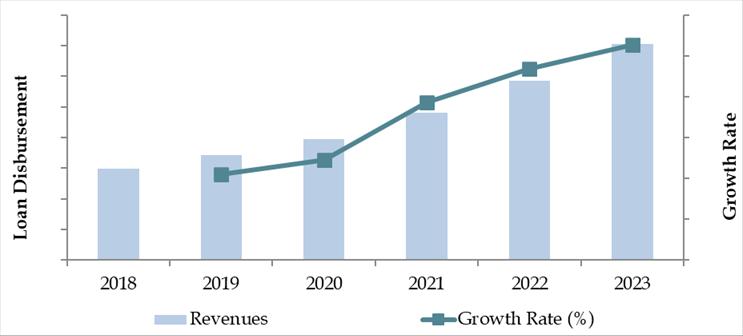
What Factors are Leading to the Growth of Saudi Arabia Auto Finance Market:
Economic Factors: The growth of Saudi Arabia's middle class and rising disposable income levels have contributed significantly to the expansion of the auto finance sector. In 2023, auto financing accounted for approximately 70% of total vehicle purchases in Saudi Arabia, making financing a crucial factor in vehicle ownership trends.
Government Initiatives: The Vision 2030 initiative has promoted financial inclusion and encouraged banks to offer more flexible financing options, particularly for first-time vehicle buyers. Additionally, the introduction of Islamic financing models has facilitated greater access to credit, aligning with consumer preferences.
Digitalization in Lending: The emergence of online financing platforms has revolutionized how consumers access auto loans, increasing transparency and convenience. In 2023, around 50% of auto financing applications in Saudi Arabia were processed digitally, reflecting a shift toward digital banking solutions. These platforms offer instant approvals, competitive interest rates, and seamless integration with automotive dealerships.
Which Industry Challenges Have Impacted the Growth of Saudi Arabia Auto Finance Market:
High Interest Rates: One of the key barriers to auto financing in Saudi Arabia is the relatively high interest rates on loans, which deter price-sensitive buyers. In 2023, interest rates on auto loans averaged between 4.5% to 7.2%, impacting affordability for many consumers.
Credit Accessibility: Many consumers, especially young and first-time buyers, face challenges in securing auto loans due to stringent credit requirements. Data indicates that approximately 35% of potential buyers struggle with financing approval due to insufficient credit history or high debt-to-income ratios.
Regulatory Compliance: Stricter regulations on loan approval processes and Shariah-compliant financing models add complexity for financial institutions. Compliance with these requirements increases administrative costs and affects the availability of financing options for certain demographics.
What are the Regulations and Initiatives Governing the Market:
Central Bank Lending Policies: The Saudi Central Bank (SAMA) has established regulatory frameworks to ensure responsible lending practices, capping interest rates and introducing policies to prevent excessive borrowing. These policies help balance market stability with consumer protection.
Islamic Auto Financing Guidelines: A significant portion of auto loans in Saudi Arabia follows Shariah-compliant financing models, including Murabaha and Ijarah. In 2023, Islamic financing accounted for nearly 65% of total auto finance transactions, reflecting consumer preference for ethical banking options.
EV Financing Incentives: To promote the adoption of electric vehicles (EVs), the Saudi government has introduced incentives such as reduced interest rates, extended loan tenures, and government-backed financing options. In 2023, EV financing represented about 5% of total auto loans, a figure expected to rise as infrastructure and government incentives expand.
Saudi Arabia Auto Finance Market Segmentation
By Market Structure: The auto finance market in Saudi Arabia is segmented into organized and unorganized lenders. Banks and financial institutions dominate the organized market due to their extensive reach, regulatory compliance, and structured financing options. Meanwhile, private lenders and dealership-based financing hold a smaller but notable share due to their flexible and quick loan approvals. The dominance of organized lenders ensures a stable and transparent financial environment, making auto financing more accessible to consumers across different economic backgrounds.
By Lenders: Major lending institutions, including Al Rajhi Bank and Saudi National Bank, lead the market due to their strong financial backing, extensive branch networks, and competitive loan offerings. Islamic financing institutions also play a key role in offering Shariah-compliant auto financing solutions. The increasing number of fintech firms entering the market is also contributing to enhanced competition, leading to improved loan terms and greater accessibility for consumers.
By Vehicle Type: Passenger vehicles dominate the auto finance market, making up approximately 75% of total loan disbursements in 2023. The growing preference for SUVs and sedans among Saudi consumers drives this segment. Commercial vehicle financing, although a smaller segment, is steadily growing due to demand from logistics and transportation businesses. The rise in demand for fuel-efficient and electric vehicles has also influenced financing trends, with banks offering tailored financing solutions for eco-friendly vehicle purchases.
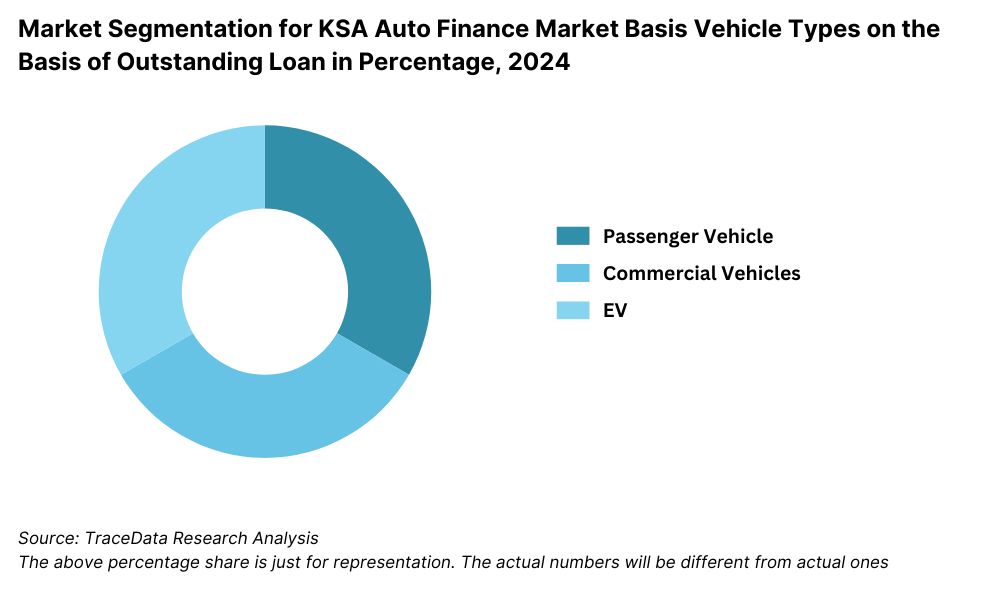
Competitive Landscape in Saudi Arabia Auto Finance Market
The Saudi auto finance market is relatively concentrated, with major banks and financial institutions dominating the space. However, the rise of digital lending platforms and fintech startups has diversified the market, offering consumers more financing options and improved services. The growing adoption of artificial intelligence and machine learning by financial institutions is further revolutionizing the market, making credit risk assessment more accurate and improving loan processing efficiency.
Name | Founding Year | Original Headquarters |
|---|---|---|
Al Rajhi Bank Auto Finance | 1957 | Riyadh, Saudi Arabia |
Saudi National Bank (SNB) Auto Loan | 1953 | Jeddah, Saudi Arabia |
Riyad Bank Auto Finance | 1957 | Riyadh, Saudi Arabia |
Saudi British Bank (SABB) Auto Loan | 1978 | Riyadh, Saudi Arabia |
Banque Saudi Fransi Auto Loan | 1977 | Riyadh, Saudi Arabia |
Arab National Bank (ANB) Auto Finance | 1979 | Riyadh, Saudi Arabia |
Alinma Bank Auto Finance | 2006 | Riyadh, Saudi Arabia |
Emkan Finance (Subsidiary of SNB) | 2019 | Riyadh, Saudi Arabia |
Saudi ORIX Leasing Company (SOLC) | 2001 | Riyadh, Saudi Arabia |
Toyota Financial Services Saudi Arabia | 2006 | Jeddah, Saudi Arabia |
Abdul Latif Jameel Finance | 1945 | Jeddah, Saudi Arabia |
Al Yusr Leasing and Financing | 2003 | Riyadh, Saudi Arabia |
Gulf International Bank Auto Finance | 1975 | Manama, Bahrain (Operations in Saudi Arabia) |
Some of the recent competitor trends and key information about competitors include:
Al Rajhi Bank: One of the largest Islamic banks, offering competitive auto financing options with flexible repayment terms. In 2023, the bank saw a 20% increase in auto loan disbursements, reflecting its strong market presence and customer trust.
Saudi National Bank: Introduced AI-based digital loan approvals, reducing processing time by 30% and increasing loan disbursement efficiency. The bank’s emphasis on leveraging digital solutions has positioned it as a leader in the auto finance sector.
Riyad Bank: Focused on EV financing, offering reduced interest rates for environmentally friendly vehicles, contributing to a 15% growth in EV auto loans. The bank has partnered with major car manufacturers to facilitate EV adoption in Saudi Arabia.
Alinma Bank: Expanded its online financing services, leading to a 25% increase in digital loan applications in 2023. Its investment in technology-driven solutions has streamlined the loan approval process, enhancing customer convenience.
Banque Saudi Fransi: Strengthened partnerships with car dealerships to offer bundled financing and insurance packages, enhancing customer convenience. The bank has also introduced new financial products aimed at attracting younger borrowers.
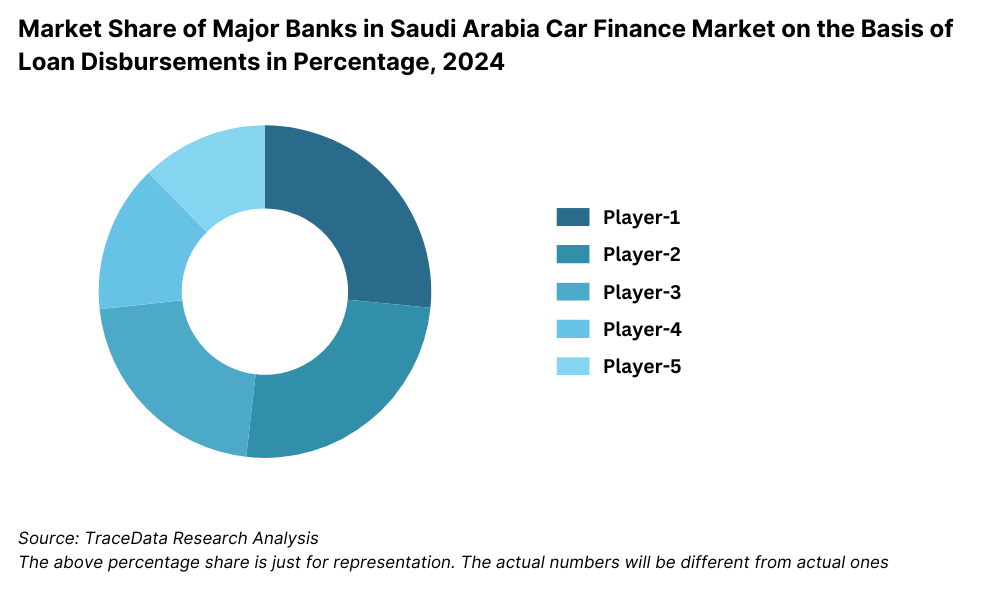
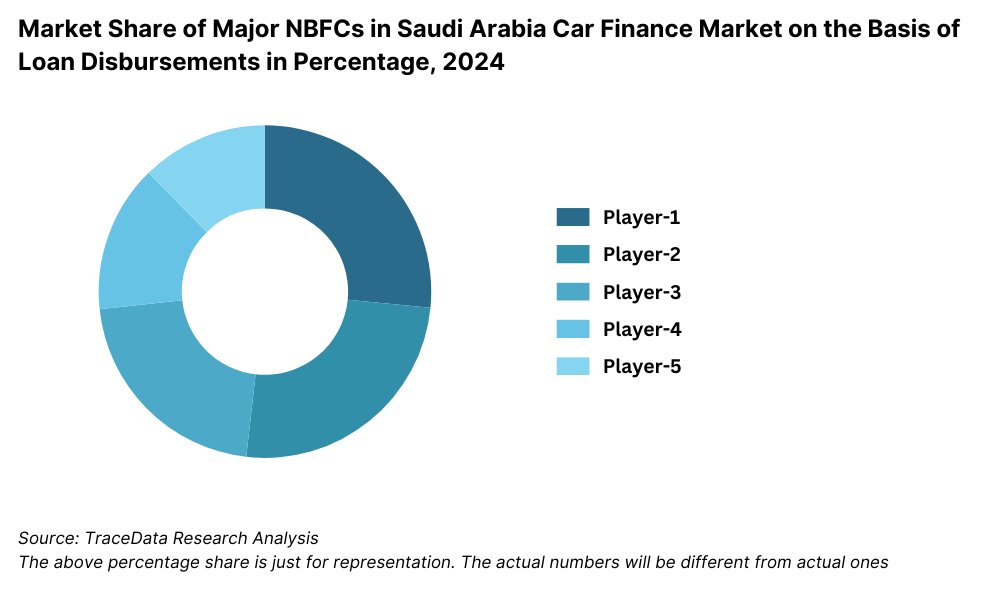
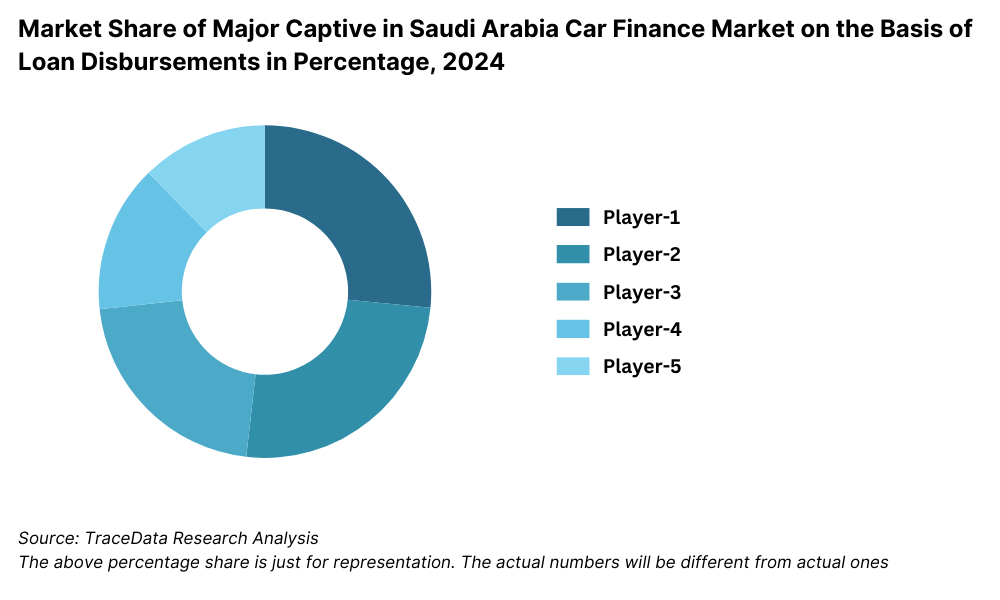
What Lies Ahead for Saudi Arabia Auto Finance Market?
The Saudi Arabia auto finance market is projected to experience steady growth by 2029, exhibiting a healthy CAGR during the forecast period. Several factors are expected to drive this expansion:
Increased Digitalization: The rapid adoption of AI-driven credit assessments, mobile banking solutions, and online loan approvals will enhance accessibility and streamline loan processing, making it easier for consumers to obtain financing.
Expansion of Islamic Financing: With growing demand for Shariah-compliant financial products, more banks are expected to introduce innovative Islamic auto finance solutions, such as deferred payment plans and profit-sharing models.
Government Incentives for EVs: Saudi Arabia’s push towards sustainability will drive an increase in financing options for electric and hybrid vehicles, as the country moves toward reducing carbon emissions and achieving Vision 2030 goals.
Sustained Economic Growth: A growing middle class with rising disposable income will continue fueling demand for auto loans, particularly among young professionals. Additionally, policies promoting women's financial inclusion are expected to positively impact the auto finance sector, increasing participation from previously untapped market segments.
Future Outlook and Projections for Saudi Arabia Car Finance Market on the Basis of Loan Disbursements in USD Billion, 2024-2029
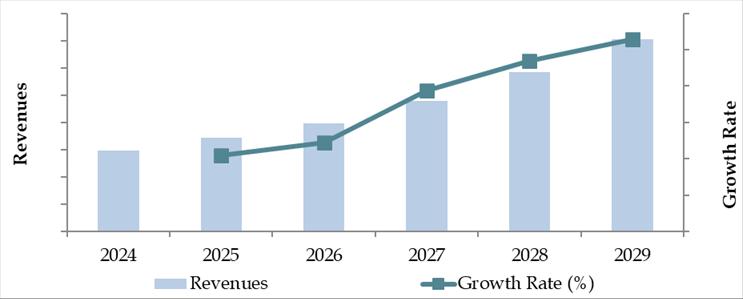
Saudi Arabia Auto Finance Market Segmentation
- By Market Structure:
- Banks and Financial Institutions
- Digital Lending Platforms
- Auto Dealership Financing
- Unorganized Sector
- Islamic Auto Financing Institutions
- By Vehicle Type:
- Passenger Vehicles
- Commercial Vehicles
- Electric and Hybrid Vehicles
- Used Vehicles
- By Financing Type:
- Conventional Auto Loans
- Islamic Financing (Murabaha, Ijarah)
- Leasing Options
- Buy-Now-Pay-Later Schemes
- By Consumer Age Group:
- 18-24 years
- 25-40 years
- 41-55 years
- 55+ years
- By Region:
- Central Saudi Arabia
- Western Saudi Arabia
- Eastern Saudi Arabia
- Northern Saudi Arabia
- Southern Saudi Arabia
Players Mentioned in the Report (Banks):
- Al Rajhi Bank
- Saudi National Bank (SNB)
- Riyad Bank
- Banque Saudi Fransi
- Emirates NBD
- Alinma Bank
- Arab National Bank
- Bank AlJazira
Players Mentioned in the Report (NBFCs):
- Al Yusr Leasing and Financing
- Al Amthal Financing Company
- Saudi Finance Company
- Emkan Finance
- Al Jabr Financing
Players Mentioned in the Report (Captive):
- Abdul Latif Jameel United Finance Co. (Toyota)
- National Finance Company (Hyundai)
- Aljomaih Automotive Financial Services (General Motors)
- United Installment Sales Co. Ltd. (Nissan)
- Al Jazirah Vehicles Agencies Co. (Ford)
Key Target Audience:
- Banks and Financial Institutions
- Online Auto Loan Marketplaces
- Automotive Dealerships
- Regulatory Bodies (e.g., Saudi Central Bank, Ministry of Investment)
- Research and Development Institutions
Time Period:
- Historical Period: 2018-2023
- Base Year: 2024
- Forecast Period: 2024-2029
Report Coverage
Choose individual sections to purchase. Mix and match as you like.
- -
- $100
4.1. Value Chain Process-Role of Entities, Stakeholders, and challenges they face.
4.2. Relationship and Engagement Model between Banks-Dealers, NBFCs-Dealers and Captive-Dealers-Commission Sharing Model, Flat Fee Model and Revenue streams
4.3. Supply Decision-Making Process
$2505.1. New Car and Used Car Sales in Saudi Arabia by type of vehicle, 2018-2024
$150- $100
- $200
8.1. Credit Disbursed, 2018-2024
8.2. Outstanding Loan, 2018-2024
$3009.1. By Market Structure (Bank-Owned, Multi-Finance, and Captive Companies), 2023-2024P
9.2. By Financing Options (Traditional Loans, Leasing, Multi-Finance Loans), 2023-2024P
9.3. By Region, 2023-2024P
9.4. By Type of Vehicle (New, Used, Electric), 2023-2024P
9.5. By Average Loan Tenure (0-2 years, 3-5 years, 6-8 years, above 8 years), 2023-2024P
9.6. By Loan Type (Conventional vs. Islamic), 2023-2024P
$40010.1. Customer Landscape and Cohort Analysis
10.2. Customer Journey and Decision-Making
10.3. Need, Desire, and Pain Point Analysis
10.4. Gap Analysis Framework
$50011.1. Trends and Developments for Saudi Arabia Car Finance Market
11.2. Growth Drivers for Saudi Arabia Car Finance Market
11.3. SWOT Analysis for Saudi Arabia Car Finance Market
11.4. Issues and Challenges for Saudi Arabia Car Finance Market
11.5. Government Regulations for Saudi Arabia Car Finance Market
$20012.1. Market Size and Future Potential for Online Car Financing Aggregators, 2018-2029
12.2. Business Model and Revenue Streams
12.3. Cross Comparison of Leading Digital Car Finance Companies Based on Company Overview, Revenue Streams, Loan Disbursements/Number of Leads Generated, Operating Cities, Number of Branches, and Other Variables
$50013.1. Finance Penetration Rate and Average Down Payment for New and Used Cars, 2018-2029
13.2. How Finance Penetration Rates are Changing Over the Years with Reasons
13.3. Type of Car Segment for which Finance Penetration is Higher
$250- $250
- $250
- $150
17.1. Market Share of Key Banks in Saudi Arabia Car Finance Market, 2024
17.2. Market Share of Key NBFCs in Saudi Arabia Car Finance Market, 2024
17.3. Market Share of Key Captive in Saudi Arabia Car Finance Market, 2024
17.4. Benchmark of Key Competitors in Saudi Arabia Car Finance Market, including Variables such as Company Overview, USP, Business Strategies, Strengths, Weaknesses, Business Model, Number of Branches, Product Features, Interest Rate, NPA, Loan Disbursed, Outstanding Loans, Tie-Ups and others
17.5. Strengths and Weaknesses
17.6. Operating Model Analysis Framework
17.7. Gartner Magic Quadrant
17.8. Bowmans Strategic Clock for Competitive Advantage
$75018.1. Credit Disbursed, 2025-2029
18.2. Outstanding Loan, 2025-2029
$30019.1. By Market Structure (Bank-Owned, Multi-Finance, and Captive Companies), 2025-2029
19.2. By Financing Options (Traditional Loans, Leasing, Multi-Finance Loans), 2025-2029
19.3. By Region, 2025-2029
19.4. By Type of Vehicle (New, Used, Electric), 2025-2029
19.5. By Average Loan Tenure (0-2 years, 3-5 years, 6-8 years, Above 8 years), 2025-2029
19.6. Recommendation
19.7. Opportunity Analysis
$400
Research Methodology
Step 1: Ecosystem Creation
Map the ecosystem and identify all the demand-side and supply-side entities for the Saudi Arabia Auto Finance Market. Basis this ecosystem, we will shortlist leading 5-6 financial institutions in the country based upon their financial performance, loan disbursement capacity, and market share.
Sourcing is made through industry articles, multiple secondary, and proprietary databases to perform desk research around the market to collate industry-level information.
Step 2: Desk Research
We engage in an exhaustive desk research process by referencing diverse secondary and proprietary databases. This approach enables us to conduct a thorough analysis of the market, aggregating industry-level insights. We analyze aspects like sales revenues, number of market players, interest rate trends, demand, and other key variables. We supplement this with detailed examinations of company-level data, relying on sources like press releases, annual reports, financial statements, and industry reports to construct a foundational understanding of both the market and the entities operating within it.
Step 3: Primary Research
We conduct in-depth interviews with C-level executives and other stakeholders representing various Saudi Arabia Auto Finance Market companies and financial institutions. These interviews serve a multi-faceted purpose: to validate market hypotheses, authenticate statistical data, and extract valuable operational and financial insights from these industry representatives. A bottom-up approach is undertaken to evaluate loan disbursements for each player, thereby aggregating data to estimate the overall market size.
As part of our validation strategy, our team executes disguised interviews wherein we approach each institution under the guise of potential customers. This approach enables us to validate the operational and financial information shared by executives, corroborating this data against secondary sources. These interactions also provide us with a comprehensive understanding of revenue streams, value chain processes, pricing structures, and lending criteria.
Step 4: Sanity Check
- Bottom-up and top-down analysis along with market size modeling exercises are undertaken as part of the sanity check process to ensure the accuracy and reliability of our findings.
FAQs
1. What is the potential for the Saudi Arabia Auto Finance Market?
The Saudi Arabia auto finance market is poised for substantial growth, projected to reach SAR 70 billion by 2029. The growth is driven by increasing vehicle ownership, a rising middle class, and expanding digital lending options.
2. Who are the Key Players in the Saudi Arabia Auto Finance Market?
The market is dominated by key players such as Al Rajhi Bank, Saudi National Bank, and Riyad Bank. Other significant players include Alinma Bank, Banque Saudi Fransi, and emerging fintech lenders offering digital financing solutions.
3. What are the Growth Drivers for the Saudi Arabia Auto Finance Market?
Key growth drivers include the expansion of Islamic finance options, increasing demand for EV financing, government support for financial inclusion, and the rise of digital auto loan platforms simplifying loan accessibility.
4. What are the Challenges in the Saudi Arabia Auto Finance Market?
The market faces challenges such as regulatory compliance complexities, high-interest rates, stringent credit approval processes, and limited financing options for lower-income groups. Additionally, economic fluctuations and inflation may impact auto loan demand.